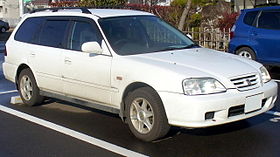
Back Honda Orthia German هوندا اورثیا Persian Honda Orthia French ホンダ・オルティア Japanese Honda Orthia Polish Honda Orthia Portuguese Honda Orthia Russian HONDA ORTHİA TLY
| Honda Orthia (EL1/EL2/EL3) | |
|---|---|
 | |
| Overview | |
| Manufacturer | Honda |
| Also called | Honda Partner |
| Production |
|
| Assembly | Japan: Suzuka, Mie |
| Body and chassis | |
| Class | Compact car |
| Body style | 5-door station wagon |
| Layout | |
| Related | Honda Civic (sixth generation) |
| Powertrain | |
| Engine | |
| Power output |
|
| Transmission | |
| Dimensions | |
| Wheelbase | 2,620 mm (103.1 in) |
| Length | 4,570 mm (179.9 in) |
| Width | 1,695 mm (66.7 in) |
| Height | 1,450–1,500 mm (57.1–59.1 in) |
| Kerb weight |
|
| Chronology | |
| Predecessor |
|
| Successor | |
The Honda Orthia (Japanese: ホンダ・オルティア, Honda Orutia) is a compact station wagon manufactured by Honda exclusively for the Japanese market between 1996 and 2002. Based on the sixth generation Civic, it was introduced in February 1996 as what Honda called a "Sport Utility Wagon" and sold at Honda Primo dealerships. The name "orthia", a variation of the Greek word orithyia, comes from Artemis Orthia in Greek mythology.[1][2]
The Orthia is available with either front-wheel drive or four-wheel drive configurations. It is powered with either 1,834 cc B18B DOHC inline-four or 1,972 cc B20B DOHC inline-four engines.
The following models were available at launch (with a choice of P (Primo) or V (Verno) equipment grades):
- 1.8GX (available in front-wheel drive configuration with manual or automatic transmission options)
- 2.0GX (available in front-wheel drive and four-wheel drive configurations with manual or automatic transmission options)
- 2.0GX-S (available in four-wheel drive configuration with automatic transmission option)
In January 1998, an additional model, the 2.0GX-S Aero, was introduced.
A facelift in June 1999 saw only the 2.0 L engine option available and the models were B, M, S (available in automatic transmission option only), M4 and L4 (available in automatic transmission option only); the last two being the four-wheel drive versions. The production of Orthia stopped in January 2002 while its sibling, the Partner, continued until March 2006. The Orthia was replaced by the Airwave station wagon and Stream minivan.[3]
- ^ "1996 Honda Orthia Wagon – Japanese Classics". Retrieved 2023-03-30.
- ^ "Honda Global | January 22, 1998 Upgrades to Orthia and Partner Series". global.honda. Retrieved 2023-03-30.
- ^ "Honda Global | October 26, 2000 Honda Introduces Sporty & Stylish New %22Stream%22 Minivan". global.honda. Retrieved 2023-03-30.